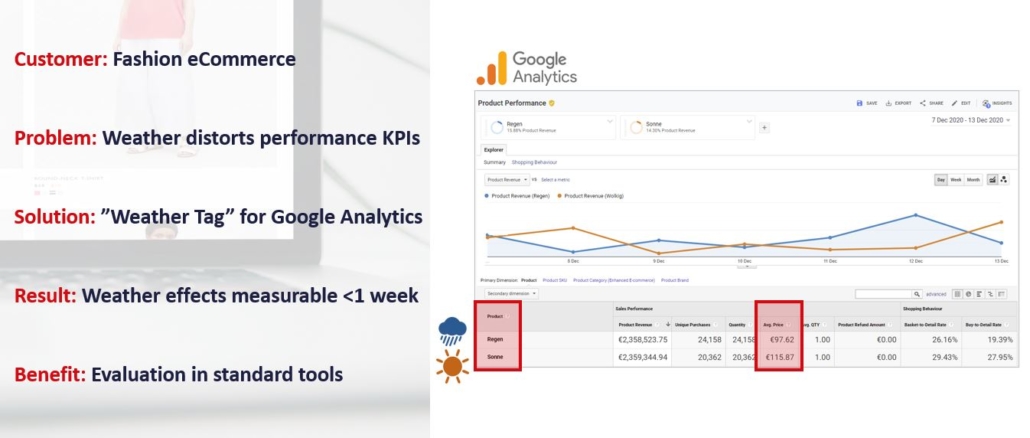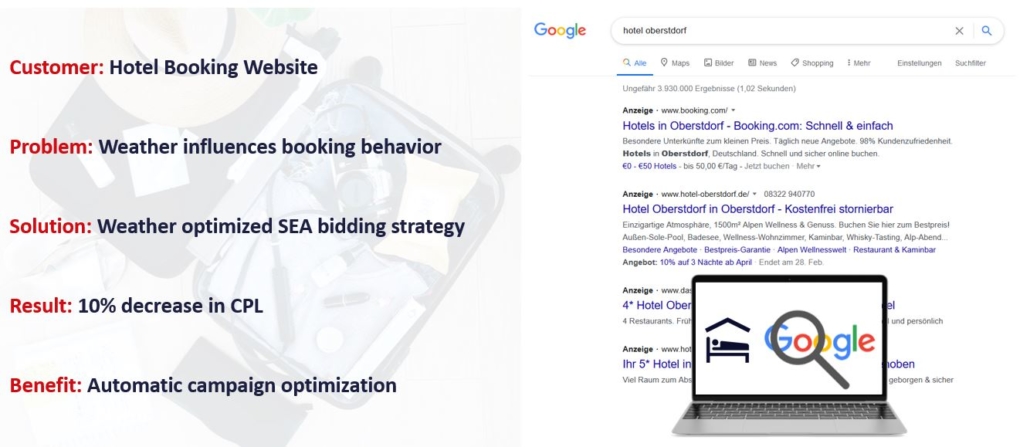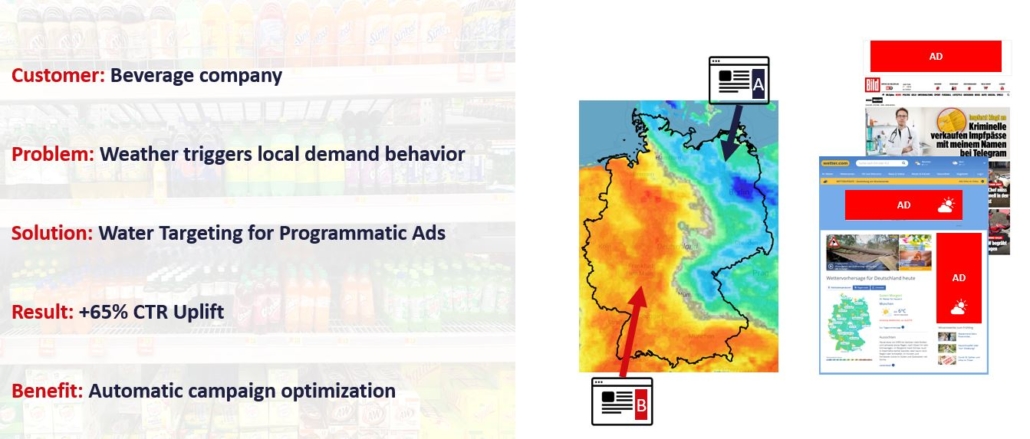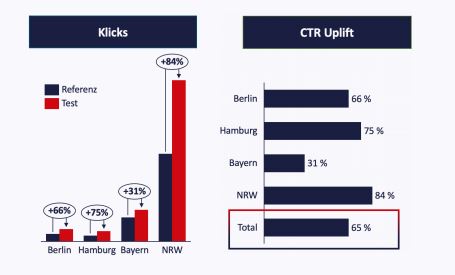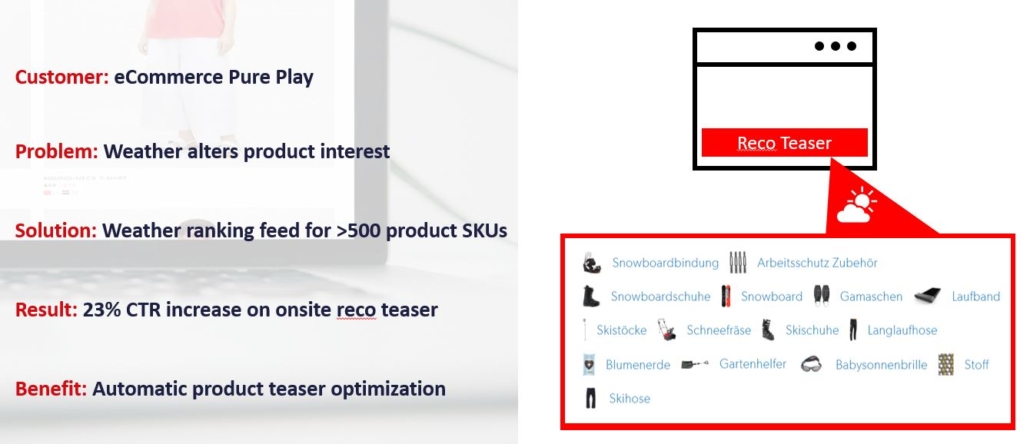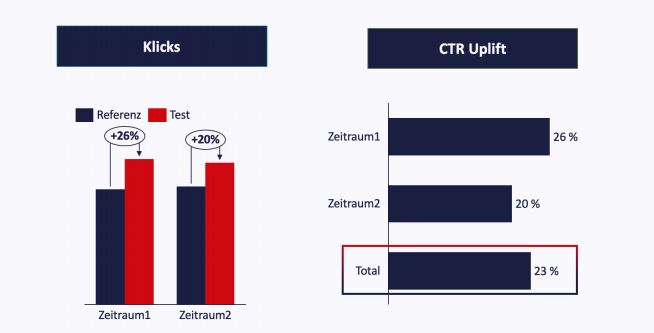Weather as a success factor in e-commerce
In the summer of 2018, e-commerce giant Zalando had to announce two weather-related profit warnings. This was similarly the case for Home24, which had to struggle with an immense “low demand” in the same far too hot summer. (Sources: https://bit.ly/3f4sHcv; https://bit.ly/3BQutHS)
Do people have better things to do than shopping online when the weather is nice? Do they prefer swimming, enjoying nature, or going to the beer garden? The reasons can be quite different. But there is no doubt that there is a clear connection between weather and demand in e-commerce, and this has also been proven scientifically. Thus, in a study published in 2017, scientists from the University of Cologne and the University of Hamburg, in collaboration with a major German online retailer, found that good weather actually has a negative effect on daily sales. Moreover, the weather effect is particularly strong at weekends and during the warm months. (Source: https://bit.ly/3l25ATN)
The fact that traffic in online stores tends to increase on “bad weather days”, while it tends to decrease on sunny and warm days, is something we also talked about in the article “Why weather data offers so much business value”. But how do you deal with this insight? What opportunities are there for e-commerce companies to exploit the potential of weather and literally capitalize on it? In this article, we will show you how it can work and which optimization potential lies behind our weather solutions.
1. Weather analytics: analyze weather effects in the sales funnel – directly in Google Analytics or Google Data Studio.
How big is the weather effect on conversion and sales really? Which products react particularly weather-sensitive? How does customer behavior change in my online store?
The Google Tag Manager template “Weather Tag” brings clarity here and provides detailed answers to all questions about the relationship between customer behavior, weather and conversion rate. With the Weather Tag, performance peaks and drops can be displayed and explained directly in the familiar Google Analytics environment. This not only provides valuable insights for analysts, but also delivers value-added insights to marketing colleagues for campaign optimization.
The Weather Tag by METEONOMIQS is set up in a few steps and is “fed” with weather data via our weather API. Detailed instructions and access to a 1-month trial are available here.
2. Weather-based GoogleAds campaigns: Increase campaign ROI with weather-optimized ads
Weather data offers a powerful lever to optimize SearchAds campaigns. Here’s an example from the tourism sector. Many people base their travel plans on the weather forecast. Accordingly, hotels and service providers can expect short-term bookings for a spontaneous short vacation or a long weekend, depending on the weather.
The booking process is usually accessed via search ads or comparison portals. In order to win the customer, it is a question of being highly visible as a provider. Therefore, it is advisable to play out more advertising when the weather is suitable and to save on advertising when it is not.
For a well-known hotel chain, we optimized the campaigns for different hotels according to the weather conditions. In a direct A/B test, we were able to prove an increase in return on advertising spend (ROA) of 10% over a period of 3 months. The reason for this is a higher booking conversion, which “rewards” the additional advertising spend on days with good weather. But beware: the effects are specific to the location and offerings of the hotel. Bad weather turned out to be advantageous for wellness and gourmet hotels; on the other hand, sports-oriented hotels tend to react more to stable, rain-free weather. With a little analysis, we can quickly determine the right weather trigger.
3. Weather targeting: align weather and marketing spend to increase visibility and performance
Which products customers are interested in depends on where they are in which weather. Not only does the weather change from day to day, but it also varies widely by region. Our product weather indices can therefore show you where it is worthwhile to advertise and where it is not, according to the weather. They are based on sales data from the GfK Consumer Panel and our weather data and can be easily integrated into campaigns as targeting segments. This works programmatically, but also on all other channels.
For a client in the beverage industry, we were able to “weather optimize” a programmatic campaign in April and May 2020. For this, we developed a specific product weather index for water that can predict where advertising for the product water is worthwhile because a lot of water will be bought there. In doing so, the index works like a kind of weather forecast for the sales of water.
The campaign was run as part of an A/B test in Berlin, Hamburg, Bavaria and North Rhine-Westphalia. On around 50 percent of the days on which the campaign ran, market interest was very high. This resulted in more than 75 percent of the clicks. Focusing on the individual federal states, there was an uplift in the click-through rate from 30 to over 80 percent. On average, the water index achieved a 65 percent increase in conversion rate.
4. Weather-based on-site content optimization: aligning content and weather to drive more sales.
It’s much the same with content as it is with advertising. Because what people are interested in – whether it’s informative or product-specific content – is influenced by the weather.
For an online retailer, we optimized the existing recommendation engine with weather data. The goal was to always recommend exactly those products on the store pages that are currently relevant due to the weather. In this way, we were able to focus on the right sales drivers, target new and returning users precisely, and significantly increase the conversion rate.
From household to fashion, garden and beauty to jewelry and multimedia: We calculated the weather dependency for over 500 product groups and integrated the results as a weather feature into the existing software. Using machine learning methods, the algorithm learns continuously and “spits out” the right products automatically. The customer benefited from a continuous improvement of its onsite product recommendations. In addition, more page impressions were generated and content management was optimized.
Conclusion: Weather drives online sales
Even if you are not physically exposed to the weather when shopping online, it still has an impact on our shopping behavior. For this reason, online retailers should not underestimate the various weather effects and should rather take them into account as a significant sales factor in their (marketing) strategy. Of course, we can’t change the weather. But on the one hand, it provides us with important insights into customer behavior. And on the other hand, we can adapt to it with the right “tool” and adjust marketing in such a way that weather optimizes and does not reduce the success of the company.

